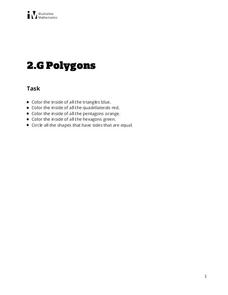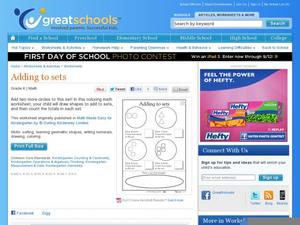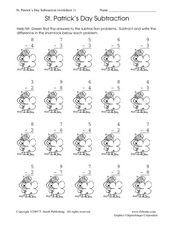Illustrative Mathematics
Polygons
Identify shapes based on their attributes. Second graders are tasked to color triangles, quadrilaterals, pentagons, and hexagons specific colors. The one thing these shapes have in common? They are all polygons.
Curriculum Corner
Spring Find a Fact Addition
Test scholars' knowledge of addition facts with a festive worksheet that makes adding a two-person game. Pairs examine a grid of numbers to locate and color addition facts. Last person to color three squares wins!
Curated OER
Which One's Different?
One of these things is not like the others! Preschoolers identify which sock and glove is different from the rest, and draw a ring around the outlier. Then, they draw a sock and glove that are different from given pictures. Color the...
DK Publishing
Who's First?
Put ribbons, rabbits, and shapes in order with a number sequence activity. Three different activities reinforce counting and number sequence, as kindergartners color particular items and identify the first, second, and third in various...
Curated OER
Complete the Picture: Snakes!
Those sneaky snakes are climbing up the trees - but they need someone to trace them! Preschoolers practice tracing curvy lines, and can color the snakes and trees when they're finished. A great way to practice tracing lines, and prepare...
Curated OER
Above, On, and Below
This boating picture is missing a few things! Scholars practice common prepositions and counting as they add details to a scene. They follow specific directions by drawing two birds above the boat, three fish below it, and two ducks on...
Curated OER
Write the Word
Combine printing practice, shape recognition, and the color red with your kindergartners. They start by tracing the word red and writing it once or twice on their own. Then, they examine an image of flowers and color all the...
DK Publishing
Finish the Picture
Youngsters add some shapes to this castle drawing before analyzing its geometry. They count the circles, triangles, rectangles, and squares. The objectives here include drawing, recognizing, and counting shapes as well as writing numbers...
Curated OER
Match the Shapes
Which shape is the same? Young geometers match a triangle, circle, rectangle, and square to their identical counterparts, connecting them with a line from left to right. Then, they do the same thing with a set of four circular shapes,...
DK Publishing
Adding to Sets
After adding to several sets of shapes, scholars count the number in each set and write the total in a box. There are four sets here calling for one, two, three, and four more shapes to be added to the existing figures. A final bonus...
Curated OER
What Shapes Can You See?
This clown is missing some things, and young counters sequence single-digit numbers to complete this juggling act. They connect four separate connect-the-dots sequences to create two triangles and two squares, then complete three more...
Curated OER
Location on a Grid
Make coordinate pairs more engaging by having beginners color-code a grid based on given locations. The grid has numbers along the y-axis and letters along the x-axis, introducing them to the ordering of coordinate pairs with the x-axis...
Curated OER
Fewer Than
Which one has fewer? There are three sets of pictures here for young counters who determine which has fewer of a given detail. They look at apples on trees, cupcakes on plates, and spots on dogs, checking off the one with fewer....
Curated OER
Sets Of
Represent multiplication as sets of items for beginners to this concept. They look at six familiar object sets and determine the total number of legs by counting the sets. There is some scaffolding here, as the first is done for them and...
Curated OER
Long, Longer, Longest
This worm might be long, but can scholars draw an even longer worm? Focus on relative size as they draw a longer worm and then a longer necklace. Next, youngsters examine two sets of objects and check off the longest in an introduction...
Curated OER
The Same
Match up these silly monsters! There are six of them pictured, and young scholars match them to their identical twins. Encourage kids to explain why they made each match, focusing on specific attributes they noticed. Have them color the...
Curated OER
The Same
These monsters are only half-drawn! Challenge scholars to observe the line of symmetry and draw in the other half to reflect the first half. There are six simple monsters in all, and scholars can color them in once finished (encourage...
Curated OER
Most and Least Likely
Explore probability with beginners using these multiple-choice visuals. They determine what they are most likely to choose from a bag by examining the contents. Each bag has three types of similar objects with one more prevalent than the...
Curated OER
Tables
Can you read this table? Learners begin to comprehend data analysis through examining two simple tables and answering comprehension questions. The first gives characteristics about three animals in yes-or-no format (i.e. "eats insects,"...
Illustrative Mathematics
How Much Pie?
The connection between fractions and division is not always intuitive for 5th graders. Pie, on the other hand, is something 5th graders can connect with. Multiple pies divided among multiple people provide the platform for your...
Illustrative Mathematics
Kitchen Floor Tiles
An interesting way to look at the kitchen floor is to count the number of tiles in the border. Fred starts with four white floor tiles and writes an expression for the number of tiles needed for the colored border. Algebra learners are...
Teacher's Guide
Subtraction Odd or Even Valentine's Day
Youngsters solve the given equations, and color each heart purple or red depending on whether it's even or odd.
T. Smith Publishing
St. Patrick's Day Subtraction Worksheet 1
You are in luck! On this St. Patrick's Day-themed worksheet, little leprechauns compute the answers to 20 one-digit subtraction problems and write the answers in the shamrocks. They may also wish to color the shamrocks. An answer key is...
Curated OER
Count the Objects
Are there more apples or pears? Learners count images of familiar objects, and write the number below. Then, they color the object group with the most in number. There are four sets of objects to compare. Consider having students circle...
Other popular searches
- Coloring Math
- Math Coloring Sheets
- Coloring Math Activity
- Map Coloring Math
- Math Coloring Worksheets
- Coloring Math Generator
- Christmas Coloring Math
- Math Coloring Pages
- Code Math Coloring
- Spring Coloring Sheets Math
- Math Coloring Puzzles
- Math Coloring Multiplication























